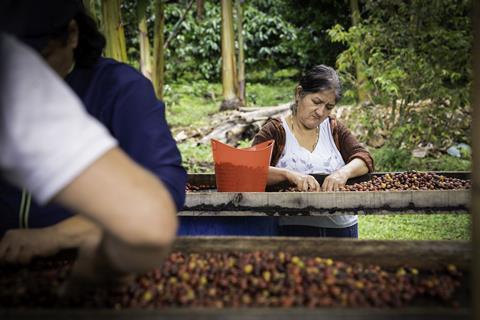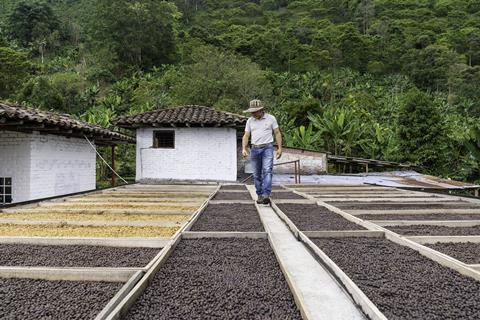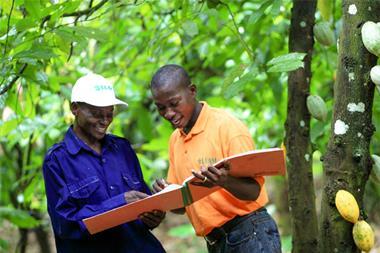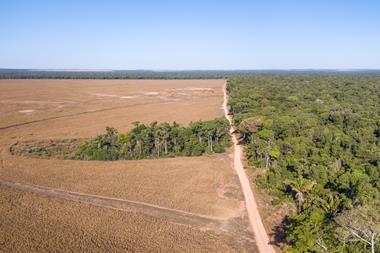Colombian coffee farmers have two major fights on their hands: downward price pressures and the effects of climate change. So how are they responding?
Deep in the Quindío hills in Colombia’s western region, José Norbey Sanchez is tending to his latest crop of castillo coffee. It is, on the face of it, a business that hasn’t changed much. His farm - La Esperanza - has been in the family for 110 years and passed down through four generations. But he is facing something very different from his predecessors: Sanchez is the first in the line grappling with the dual pressures of climate change and falling prices.
The coffee-growing Colombian mountain region is warming at a rate of 0.3°C per decade, according to a study by coffee agronomist Peter Baker. That is having a dramatic effect on weather patterns in the region, altering the flowering and fruiting cycles of coffee and increasing pests and diseases.
The disruption couldn’t come at a worse time. Because it coincides with downward pressures on global coffee prices. For the majority of last year, coffee traded below the cost of production, according to Rabobank - largely thanks to “overwhelming” Brazilian production and a weak real.
All of which has left Colombian farmers such as Sanchez in a vulnerable position. Many are choosing to leave the market due to the pressures. In the 18 months to May 2019, Colombia lost 40,000 hectares of coffee planting area, according to the National Federation of Coffee Growers of Colombia. Since the 1990s, the total amount of land used for coffee has shrunk by 20%.

Juan Antonio Rivas, senior VP coffee sustainability at global agri-business Olam International, warns this could have global ramifications if it continues. “Then we and the rest of the industry will struggle to find the supply to meet demand.”
So what are the options for Colombian coffee farmers, and what are they doing to address the challenges? The Grocer visited the Quindío region to find out.
One thing is evident: the dual pressures of climate change and low prices have forced farmers to think more carefully about every aspect of their businesses. With the support of organisations like Olam, they are honing their skills in everything from accounting to agricultural techniques such as optimal tree spacing.
“My dream is for my children to continue my coffee business and my legacy”
But farmers are also making fundamental changes to the way they work. Most notably, that’s in their choice of crop. In the past, Colombian coffee producers have grown arabica varietals of cherry. As these varietals are deemed the gold standard, it’s been a safe strategy - until now. Farmers have found these arabica cherries are vulnerable to changes in the weather - which is forcing them to look at alternatives.
Sanchez, for example, is one of the farmers using a more robust hybrid cherry: castillo. As a rust-resistant bean, it is better able to handle the challenges of climate change. Using this crop alongside renovation and agronomy best practice, he has been able to increase his yields from 2.1 to 3.75 metric tonnes of dry parchment per hectare with the help of Olam agronomists.

Other farmers are diversifying into even higher-quality yields. Take La Divisa farm, which is concentrating on specialty coffee production. Farmer Diofanor Ruiz is experimenting with alternative fermentation and drying methods to produce a higher-quality cup. These include flotation to select the best cherries by density, fermentation with crates, tanks and anaerobic processes, and using both sun and mechanical drying. His farm now produces 50% specialty coffee, compared with 10% six years ago.
That specialty aspect pays dividends. A coffee bean that measures 85 on the scoring system by the Speciality Coffee Association of America - just three points above a standard “clean” cup - can fetch an additional 20% to 30% on the base price. Ruiz, who also works with Olam, wants to hold this up as an example of how coffee farming can work for future generations. “I want to show what profitable coffee farming looks like to the community to present it as an attractive opportunity to young people.”
Sanchez is similarly thinking about future generations. “My dream is for my children to continue my coffee business and my legacy,” he says. “Now that actually seems possible.”
It’s a crucial point. Because without the buy-in of future generations, Colombian coffee could face yet another crisis.




















No comments yet